The state government plans to put up street names and road signs in multiple languages at heritage areas here for the benefit of tourists and visitors.
State Local Government, Traffic Management and Environment Committee chairman Chow Kon Yeow said yesterday that the languages would depend on the cultural characteristics of the streets in question.
“There have been requests for road signs in various languages now that George Town has received Unesco recognition as a world heritage site. The state has, in principle, agreed to have signs in Bahasa Malaysia, English, Chinese and Tamil, and maybe even Arabic,” he said.
 Chinese signs: Penang residents riding past one of the six new road signs in George Town yesterday. The six signs were put up by a group of Gerakan members on Monday.
Chinese signs: Penang residents riding past one of the six new road signs in George Town yesterday. The six signs were put up by a group of Gerakan members on Monday.Chow noted that the Federal Government had also approved an allocation to put up signboards in various languages around George Town.
On the six street signs put up by several Gerakan members, led by former Penang Municipal Council councillor Dr Thor Teong Ghee, Chow said he had instructed the council to give notice to the group to remove them.
“The council will advise them to take down the signs themselves, unlike in the past when the council under the previous administration used to pull down signs put up by the DAP within two hours,” said Chow.
On Monday, Dr Thor and six others put up the road signs in Chinese to remind the DAP that it had to keep its word to come up with such road signs now that the party was helming the state. The six signs were for Beach Street, Burmah Road, Macalister Road, Carnarvon Street, Chulia Street and Jalan C.Y. Choy.
Chief Minister Lim Guan Eng said there was no reason for anyone to politicise the issue as this was the people's aspiration. He likened the need to have multilingual road signs to the multilingual announcements at airports which were a necessity.
However, Tanjung Umno Youth division chief Shaharrudin Hassan urged the local government and government agencies to only allow road signs in the national language.
“If the Malays can compromise with not having road signs in Jawi or Arabic, we do not see why the other races cannot practise a similar thing,” he said.
When contacted, Dr Thor said he would wait for the council's notice, but hoped that the signs could remain until the council put up its own.

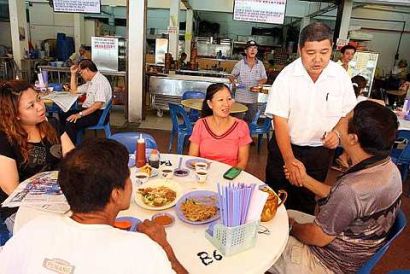
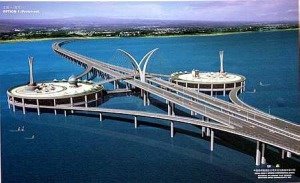



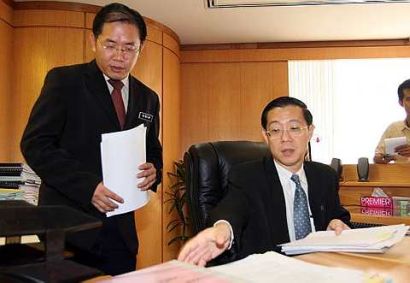
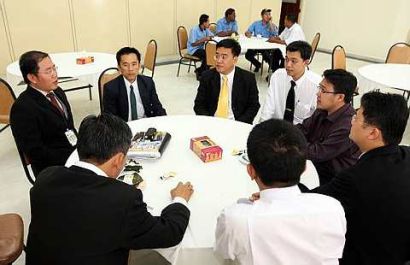
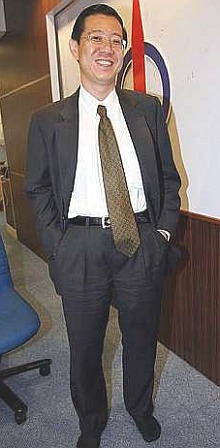




1 comment:
It is a good idea to provide tourists and locals with multi-language directions, but as I have explained in my blog http://betelnutchronicles.blogspot.com/2008/07/of-road-signs-road-science-and-road.html , cramping too many words in one street sign can be very confusing. I take the liberty of posting the article below:
Road Signs, Road Science and Road Sighs
http://betelnutchronicles.blogspot.com/2008/07/of-road-signs-road-science-and-road.html
By Edmond R
The live telecast of the Penang State Legislative Assembly signifies a new direction for the state government. However, as reported in the article in Malaysiakini ‘Role swapped in Penang, but not mentality’ http://www.malaysiakini.com/news/86569 , hitches in adjusting to the drastic role reversal between the government and the opposition are to be expected.
Therefore it is not surprising to see Barisan Nasional members still displaying their arrogance and ingrained gangster-like attitudes despite being in the opposition and the new government leaders still trying get rid of their opposition mentality. After many decades of Barisan Nasional’s lording over the State Assembly and DAP’s continuous defensive streak, it might take a while before both sides settle down in their new roles.
After catching a glimpse of the broadcast over the internet, I must say that the proceedings went on quite well. Of particular note are the quality of speeches by Chief Minister Lim Guan Eng, Chow Kon Yeow and Lim Hock Seng who each spoke with purpose and direction in eloquent Bahasa Malaysia. Let us hope they continue to do a good job and lead Penang back on the road to success and prosperity.
However I am a bit concerned about the government’s latest decision to put up street names and road signs in multiple languages at heritage areas here for the benefit of tourists and visitors. I agree that multiple language sign boards are helpful in giving directions to tourists and a short historical account of the road would add more colour to our heritage sites.
But I hope the government is not proposing to cramp four or five versions of a street name on one single metal plate. Any road sign should be large, clear, correct and direct so that drivers and pedestrians can recognize it at one glance. Road signs are not meant to be pieces of Shakespearean literature which require squinting and scrolling before we catch the meaning.
Perhaps the government should first consider these arguments below before putting up the new signs.
Size of the Sign
The size of street signs should be standardized to maintain uniformity and recognition. The current street signs with white letters on green background are quite practical. The Bahasa Malaysia version of the street name dominates the plate and the English version and the area postcode are displayed below.
Putting a few more languages on that small sign will defeat the purpose of putting it up in the first place. Not only will visitors be lost, but the locals will even find it hard to decipher its meaning.
The only possible solution is to maintain the current bilingual street signs and erect another unobtrusive sign next to it to include the various translations. This sign board should be elegantly designed to complement the surrounding area and it should also contain a historical description of the road and how the name came about.
Clarity
All road signs and street names should be clearly spelled out. Multilanguage signage is actually geared towards tourists and visitors who only know one language. I can see the government’s logic behind this move. But we must understand that the majority of tourists nowadays are multilingual and most of them understand English at the very least. Even the Arab tourists whom I have come across so far are proficient in English.
Putting too many languages on a sign board will confuse the reader. This is especially true when the government intends to introduce the local name for the road which at most times, are totally different from the English version.
Take for example the famous Campbell Street which is known to locals as ‘Sin Kay’, which literally means ‘new road’. If you are a bilingual tourist from China who knows Chinese and English, you will be totally confused because Campbell is the name of a person, whereas ‘Sin Kay’ would mean ‘new road’.
Then we have Cintra Street which is also known as “Jee-pun Kay” which in turn means Japanese Street. Do you know why it is called that? According to the elderly people in Penang, Cintra Street used to be lined with seedy brothels servicing the Japanese army during World War Two and the word ‘Kay’ does not mean ‘street’ but ‘chicken’; a word which the locals use to refer to prostitutes.
Now, wouldn’t it be embarrassing if we have to explain this to our guests from all over the world? Heaven forbids I have not even mention about what goes on in Lorong Gaharu (Incense Street) and Kampung Pisang (Banana Village)! Those who are interested to know may email me privately.
Spelling
Before we add more languages into our street signs, the government should make sure that the spelling of streets and places are correct and standardized first. For years, we have been in a quandary as how some of these places are spelled.
Should it be Tanjung Bungah, Tanjung Bunga or Tanjong Bunga? Is Ayer Itam correct or should it be spelled Air Hitam? What about Batu Ferringhi which is sometimes spelled without the letter ‘H” as Batu Ferringi?
If we locals are already confused, imagine what sort of nightmare tourists will encounter.
Get the names correct first. Hold a dialogue with locals and experts if necessary. Organize a conference to get the names straight once and for all. This is what we should have done years ago.
Quick Glance Test
A street sign is only trustworthy if you can read it within one second of glancing at it. If it takes longer than that, you will end up hitting a trishaw across the road or run over a motorcyclist. I foresee many accidents in the near future if our sign boards are cluttered with multiple languages.
I believe the government’s decision to erect the new street signs are mainly to provide better directions for tourists and locals. However I am sure it is also part of their effort to fulfill DAP’s election promise and to response to Gerakan’s latest taunt, in which the latter put up their own Chinese language road signs in various places.
Let us put politics aside and stop littering our beautiful city with unnecessary road signs and signboards. I have seen signboards that are so big that it hides the whole building it is supposed to highlight. Then there are signboards which are hidden by tree trunks and Municipal Council rubbish bins. I am sure many of you have also road signs being used to hang clothes for drying.
If at all, it is necessary to place street names and road signs with multiple languages, then it should be done professionally and aesthetically. As I have prescribed above, we should keep the current bilingual street signs as they are and erect a non-obtrusive sign board beside it to provide the various translations and a short historical significance of the road. A general map of George Town can also be incorporated in the sign board to show the tourist where they are and what’s in store in the surrounding area.
A proper road sign should be more of a ‘road science’ and less of a ‘road sigh’.
Post a Comment